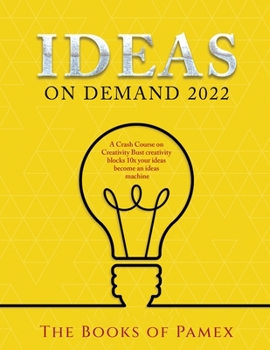Ideas on Demand 2022: A Crash Course on Creativity Bust creativity blocks 10x your ideas become an ideas machine
Each one of us is born creative.
And then one day, we went to school.
Our formal education began with formally muzzling our creativity. By the time we completed our education, the process of 'de-creativization' was complete. The whole process is so effective that whenever we come across creative people, we consider them as gifted individuals. The reality is that all of us were as gifted as the creative ones. The only difference is, somehow, they managed to survive the 'de-creativizing' effect of formal education.
"Every child is an artist. The problem is how to remain an artist once he grows up."
Pablo Picasso
I was no different. I was blissfully unaware, leading a perfectly uncreative life. Then a jolt came in the form of a most unexpected promotion in my corporate career.
Let me explain.
I started my career as a medical representative. But somewhere deep inside, I believed that the right place for me was in marketing. But I had neither thequalification nor the required e xperience. Hence, I focused on my sales career, rose to a managerial position, and continued to move up in my career
ladder. Meanwhile, I also added a management qualification. Again, the thought of moving into marketing came to me, but by then, I had already moved up the ladder as a line manager. I thought shifting to marketing would mean starting from scratch, at the lowest marketing position.
At that time, I didn't want to let go of my hard-earned middle management position.
Besides, I was performing well and already expecting my next promotion. Soon, the promotion happened. But it came with a big surprise. I was promoted to marketing manager without any prior marketing experience. It was like a dream come true!
Those were the days when FMCG ad agencies had not yet entered the pharmaceutical arena. Hence, to be a successful pharma marketer, creativity was a mandatory prerequisite. As a marketing head, I had a bright team of brand managers who expected me to help them provide creative, differentiating ideas. Not just my team, but my seniors too had high expectations from me. With the pressure of such high expectations, I could think of only mediocre, run-of-the-mill ideas.
My reputation was at stake. I had only two choices - be creative or be regarded as a failure in my new
role as a marketer. I opted for the first one. Once I made the decision, I chased creativity with an intense focus. I searched and consumed every word I came across on the subject of creativity and innovation and tried to apply it to my day-to-day work. Regardless of the quality of ideas, I focussed on churning out ideas every single day. Initially, the results were pathetic. Fortunately, I had no choice but to keep trying.
Gradually, the quality of ideas started improving. In the process, I learned the art of connecting dots. My ideas started getting better. Even others began to notice the difference.
I had crossed the first barrier.
Finally, the real breakthrough came when I learned to identify and challenge the hidden assumptions that stop everyone from getting breakthrough ideas. (There is a lot of interesting stuff on shattering assumptions that awaits you in this book.)
Fast forward to today. Since 2008, my creative agency helps pharmaceutical companies build big brands. I also offer strategic consulting to organizations looking for innovative ideas to stay ahead of the competition.
Today, my sole source of livelihood is strategy, marketing, creativity, and innovation.
This book has anecdotes, stories about great minds, case studies, scientific evidence, and many powerful techniques and exercises. Besides, I have put20 years of my first-hand experience and lear ning into it. All this is to helpyou generate Ideas on Demand, which is the promise of this book.
Let's get started!





